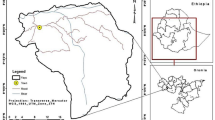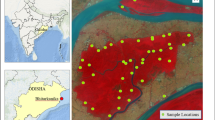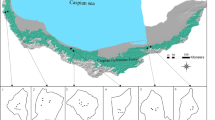Abstract
Spatio-temporal assessment of the above ground biomass (AGB) is a cumbersome task due to the difficulties associated with the measurement of different tree parameters such as girth at breast height and height of trees. The present research was conducted in the campus of Birla Institute of Technology, Mesra, Ranchi, India, which is predominantly covered by Sal (Shorea robusta C. F. Gaertn). Two methods of regression analysis was employed to determine the potential of remote sensing parameters with the AGB measured in the field such as linear regression analysis between the AGB and the individual bands, principal components (PCs) of the bands, vegetation indices (VI), and the PCs of the VIs respectively and multiple linear regression (MLR) analysis between the AGB and all the variables in each category of data. From the linear regression analysis, it was found that only the NDVI exhibited regression coefficient value above 0.80 with the remaining parameters showing very low values. On the other hand, the MLR based analysis revealed significantly improved results as evidenced by the occurrence of very high correlation coefficient values of greater than 0.90 determined between the computed AGB from the MLR equations and field-estimated AGB thereby ascertaining their superiority in providing reliable estimates of AGB. The highest correlation coefficient of 0.99 is found with the MLR involving PCs of VIs.
Similar content being viewed by others
References
Crippen RE. 1990. Calculating the vegetation index faster. Remote Sensing of Environment, 34: 71–73.
Dong J, Kaufmann RK, Myneni RB, Tucker CJ, Kauppi PE, Liski J, Buermann W, Alexeyev V, Hughes MK. 2003. Remote sensing estimates of boreal and temperate forest woody biomass: carbon pools, sources, and sinks. Remote Sensing of Environment, 84: 393–410.
Fraser RH, Li Z. 2002. Estimating fire-related parameters in boreal forest using SPOT VEGETATION. Remote Sensing of Environment, 82: 95–110.
Huete AR. 1988. A soil-adjusted vegetation index (SAVI). Remote Sensing of Environment, 25(3): 295–309.
Jensen JR. 2006 (2nd Edition). Remote Sensing of the Environment: An Earth Resource Perspective. South Carolina: Prentice Hall, 592pp.
Kumar R. 1999. Characterization of Rice Growing Ecosystem Using Remote Sensing and GIS Techniques. Ph.D. Thesis (unpublished), Birsa Agricultural University, Ranchi, India.
Lefsky MA, Cohen WB., Spies TA. 2001. An evaluation of alternate remote sensing products for forest inventory, monitoring, and mapping of Douglasfir forests in western Oregon. Canadian Journal of Forest Research, 31(1): 78–87.
Levesque J, King DJ. 1999. Airborne digital camera image semivariance for evaluation of forest structural damage at an acid mine site. Remote Sensing of Environment, 68: 112–124.
Lillesand TM, Kiefer RW, Chipman JW. 2007 (6th Edition). Remote Sensing and Image Interpretation. Madison: John Wiley & Sons, 784pp.
Lu D. 2006. The potential and challenge of remote sensing-based biomass estimation. International Journal of Remote Sensing, vol. 27(7): 1297–1328.
Majumdar A. 2010. Biomass Estimation of Sal (Shorea robusta) through Principal Component Analysis of Satellite Data. M.Sc. Thesis (unpublished), Birla Institute of Technology Mesra, Ranchi, India.
Richardson AJ, Wiegand CL. 1977. Distinguishing vegetation from soil background information. Photogramnetric Engineering and Remote Sensing, 43(12):1541–1552.
Rouse JW Jr, Haas RH, Deering DW, Schell JA, Harlan JC. 1974. Monitoring the Vernal Advancement and Retrogradation (Green Wave Effect) of Natural Vegetation. NASA/GSFC Type III Final Report, Greenbelt, MD: p. 371.
Roy PS, Ravan SA. 1996. Biomass estimation using satellite remote sensing data — An investigation on possible approaches for natural forest. Journal of Biosciences, 21(4): 535–561.
Shrestha HL. 2003. Comparative Evaluation of Different Spatial Resolution Data for Timber Volume Estimation. M.Sc. Thesis, International Institute for Geoinformation Science and Earth Observation, Enschede, Netherlands.
Author information
Authors and Affiliations
Corresponding author
Rights and permissions
About this article
Cite this article
Patel, N., Majumdar, A. Biomass estimation of Shorea robusta with principal component analysis of satellite data. Journal of Forestry Research 21, 469–474 (2010). https://doi.org/10.1007/s11676-010-0100-5
Received:
Accepted:
Published:
Issue Date:
DOI: https://doi.org/10.1007/s11676-010-0100-5




